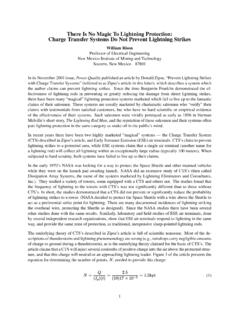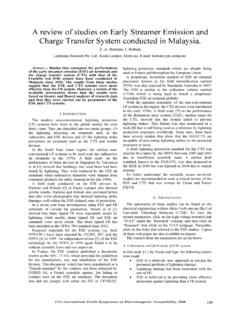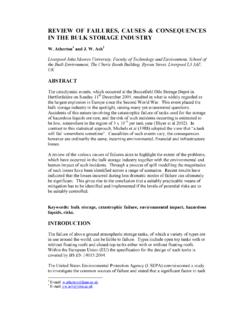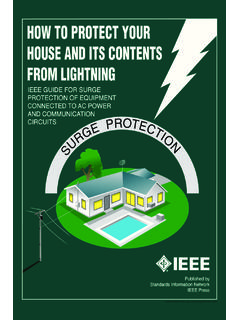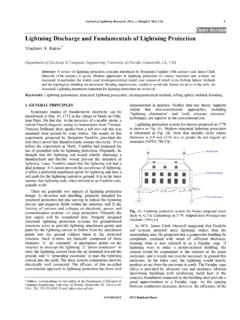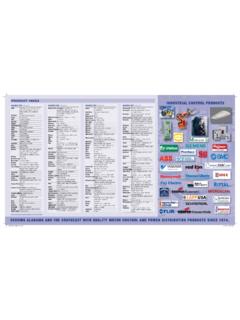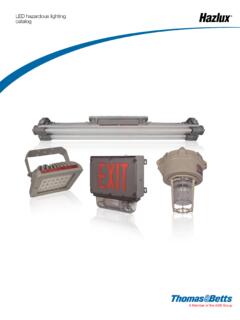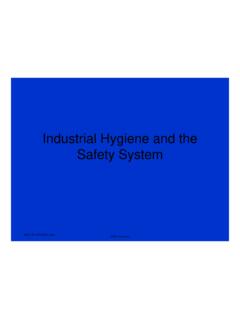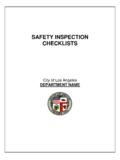Transcription of Lightning Elements of industrial accidentology
1 LLiigghhttnniinngg EElleemmeennttss ooff iinndduussttrriiaall aacccciiddeennttoollooggyy FFrraannccee,, 11996677 -- 22000077 A Lighting and its B - Types of activities ..3 C Typology of D - E - F Lessons Appendix 1: French accidents Appendix 2: Foreign accidents Photo Credit:US National Oceanic and Atmospheric Administration 1 In Greek and Roman mythology, Lightning is depicted as a fiery and zigzag bolt. It is the weapon and attribute that Zeus (Jupiter) used to fight enemies and establish his supremacy over the gods. Lightning was reputed to comprise three thunderbolts: the first to warn, the second to punish and the third to destroy the world marking the end of time.
2 Lightning is still feared in current times, more so as a physical phenomena resulting in substantial damage or victims than a divine manifestation. In industrial facilities, it results in equipment damage including failure and may jeopardise the safety of equipment, people and environment. The accidentology analysis presented in the following pages describes the impact of Lightning on industrial facilities in France. The analysis is based on events recorded in the ARIA database (Analysis, Research and Information on Accidents) managed by the Risk Prevention Department of the French Ministry of Ecology, Energy, Sustainable Development and Town The ARIA database records 101 Lightning accidents that took place between October 1967 and July 2007 that impacted or were likely to impact classified installations.
3 Due to lack of information, the accident sample in all likelihood is not fully representative of the accidents occurred. Moreover, keeping in mind the available data, this work can only be considered as a statistical survey. The list of illustrative French accidents is included in appendix 1. Fifty Lightning accidents that occurred outside France are also recorded in the ARIA database in appendix 2. The summaries are characterised by the 4 indices referring to the 18 parameters of the scale made official by the Committee of Competent Authorities of the Member States which oversees the application of the SEVESO directive. These indices correspond to: Each index is rated on a scale of 6 according to the European rating rules that can be consulted on the website 1 The ARIA database is essentially a record of the accidental incidents which have or could have been hazards to human health or public safety , agriculture, nature or the environment.
4 For the most part, these incidents result from the activities of factories, workshops, warehouses, work sites, breeding operations, etc. which are classified under the legislation relating to Classified Facilities, as well as from the transport of hazardous materials. The recording and analysis of these accidents and incidents, in France and abroad, have been organised since 1992. Dangerous materials released Human and social consequences Environmental consequences Economic consequences 2 A Lightning and its effects Meteorological phenomena Thunder clouds (cumulo-nimbus) create weather conditions that favour the accumulation of electrical charge and consequently the creation of a giant condenser. - a significant temperature difference between the top and bottom of the cloud results in violent air movements; - the presence of various particles such as ice and dust that facilitate the removal or addition of electrons according to the charge by triboelectric effect (exchange of electrons between 2 different materials) - since air (and its constituents) is electrically charged, zones with different electric potentials are created in the clouds: negative at the bottom and positive at the top.
5 This results in a strong electric field. When this electrostatic field exceeds the dielectric limits of the air (variable depending on humidity and pressure conditions) a Lightning discharge aimed at re-establishing the electrostatic balance is observed. Distribution of electric charge in a cloud In the analysed accidents, the Lightning impact mainly results in: - thermoelectric effects: a very strong flow of electric current heats materials and often causes significant even spectacular material damage. - electromagnetic effects: Lightning current creates an exceptionally intense electromagnetic field and voltage. This results in very powerful parasite electrical pulses that are responsible for damage in a majority of cases according to statistics.
6 These electrical pulses are enough to damage sensitive electronic material even if Lightning strikes far away. - conduction (pace voltage): when Lightning strikes the earth, the electrical charges dissipate in the soil and create a strong electric voltage. Depending on the nature of the soil (its resistivity) and impact distance, the current can pass through the lower limbs of human being. Information on the possible effects of Lightning on structures and utilities is available in the French standards documents (CEI and NF EN 62305-1 5). The standard does not deal with some underground pipes and power or transmission lines. As shown in the Lightning map created by the company M t orage covering the period 1996 2005, all regions in France are prone to thunderstorms and are likely to be impacted by Lightning .
7 Source : M t orage B - Types of activities concerned All industrial and agricultural sectors are potentially exposed to the risks of Lightning : chemical industry (ARIA 1884, 2715, 3707, 5874, 8885, 9996, 10074, 11262, 11562, 15749, 15833, 18563, 25147, 27506, 30199, 30325, 30894, 31773, 33604) agricultural activities and animal husbandry (ARIA 5870, 5871, 7168, 7663, 7664, 12937, 15849, 15934, 16412, 20662, 21493, 22776, 25463, 33277) refinery (ARIA 6277, 15215, 26503, 26535, 26577, 26579, 30892) food industry (ARIA 8909, 16283, 18325, 20844, 25617, 33120) nuclear production and transformation sites (ARIA 343, 4507, 19716) pipeline transport (ARIA 5678, 7508, 7545, 23626, 30130) .. The distribution of accidents in the national territory mainly depends on the density of implantation of facilities, their vulnerability, as well as the intensity and frequency of thunderstorms.
8 Some regions show a greater number of recorded events (Rh ne Alpes, Provence Alpes C te d Azur, Midi Pyr n es, Aquitaine). This observation is consistent with the Lightning map published by M t orage. The number of Lightning impacts on ground per km per year is different from the keraunic level defined by the average number of days per year when thunder can be heard. 4 C Typology of accidents Table 1 presents the main typologies of the accidents included in the sample: Typology* No. of cases Fire 70 Emission of dangerous substances or pollutants 30 Fall / projection of equipment 3 Explosion 10 * Lightning may sometimes generate several typologies ( explosion with projection of equipment followed by fire ARIA 8885).
9 Table 1 Fire is the most commonly observed typology (70% cases) and concerns both industrial units as well as farm and livestock buildings (ARIA 3707, 6277, 7168, 7664, 8885, 9996, 10074, 11262, 11562, 12937, 15215, 15849, etc.). Fire-fighting operations often last long (ARIA 4801, 7664, 12948, 18325, 25440, 33120). Rescue services are likely to face problems due to tough climate conditions as well (heavy rains preventing the fire smoke from rising, violent winds helping fire to spread ARIA 9996, 12948). In over 10% cases, fires (ARIA 4801, 12948, 15689, 23626, 24526, 27885, 29439, 30894, 33120) spread to electrical equipment (ARIA 4801), gas pipes (ARIA 23626), flammable product storage sites (ARIA 24526), buildings (ARIA 27885), etc.
10 To prevent or curtail the spread of fire, the electrical fire protection equipment (sprinkler network pump, etc.) must be protected from the effects of Lightning (ARIA 33544) and from frequent power cuts during thunderstorms. Foreign accidents ARIA 8183 24/10/95 INDONESIA CILACAP Lightning struck the automatic gauging device of a 38,800 m fixed-roof tank being filled with kerosene. The poor equipotentiality of the device resulted in sparks that triggered a fire. The gaseous cloud over the tank exploded destroying the roof. The burning liquid spread the fire to six other tanks in the dike. The residents and staff members were evacuated. No victims were reported. Nearly 600 homes were damaged and some hundred water bodies were polluted.
